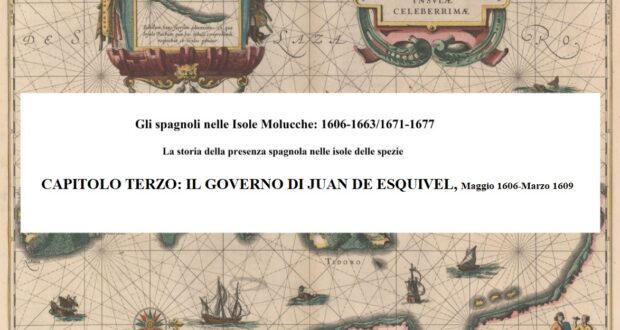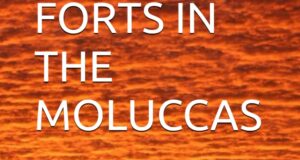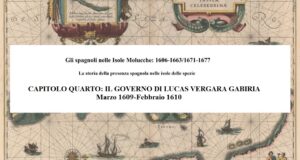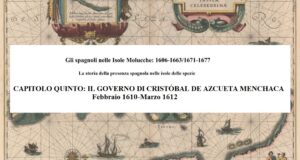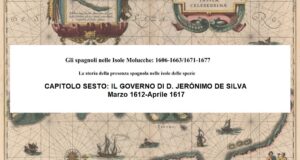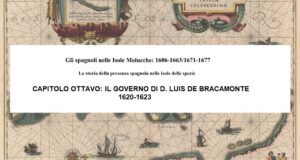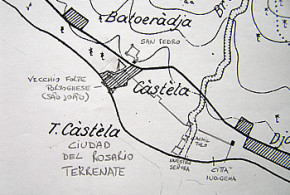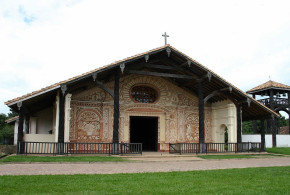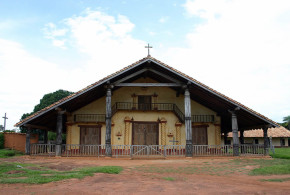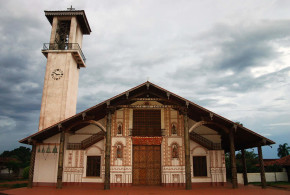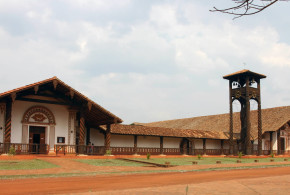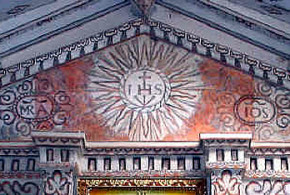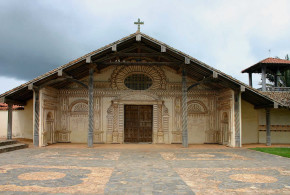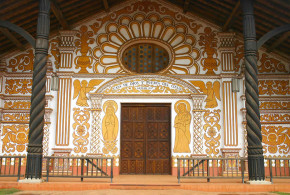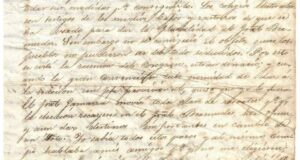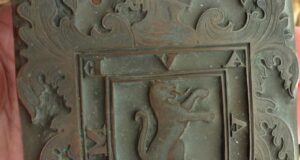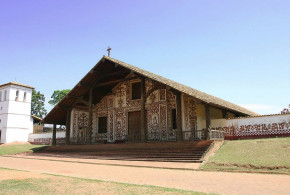This post is also available in:
![]() Italiano
Italiano
The Spaniards in the Moluccas: 1606-1663/1671-1677. The history of the Spanish presence in the spice islands
Written by Marco Ramerini. 2005-2020/23
CHAPTER THREE: THE GOVERNMENT OF JUAN DE ESQUIVEL, May 1606-March 1609
Governor Acuña, after conquering Ternate, left for Manila on May 3, 1606, where he arrived on June 2, 1606. Before leaving Ternate, he appointed the “mestre de campo” Juan de Esquivel as commander of the fortress of Ternate.1 At his return, Acuña will be short-lived, in fact he will die on June 24, 1606, perhaps poisoned, a few days after his arrival in Manila.
A PRECARIOUS CONQUEST
Acuña’s haste to return to Manila, and the sultan’s deportation to Manila will be the main causes that will prevent the consolidation of Spanish power in the islands and therefore consequently will allow the Dutch to find fertile ground among the Ternatese natives. Esquivel also recognizes that Acuña left Ternate in a confused situation, without having completely subjected the population and especially the chiefs who had remained and who had retreated to the coast of Halmahera in the villages of Sabubo and Gilolo. 1
NEW FORTIFICATIONS IN TERNATE AND TIDORE
In Ternate, where the old fortress was small and not very defensible, it was decided to build a new fortress in an “eminent part, mayor y más fuerte”. Unlike what it tells us Argensola2 that is, that the new fort before Acuña’s departure for Manila was already finished and equipped with embankments and that the old fort had been reduced to “a short sitio”, it seems that the new fort was still to be built and that the old one was in bad condition, its walls according to Esquivel’s judgment would not have resisted any artillery fire and moreover its position was dominated by a hill which made the fort practically indefensible “with a gran padrastro a la parte del volcán, de suerte que no servía al enemigo de más que de casa en que bivir”, the only noteworthy defensive works of the city seem to have been the two walls that defended the two sides of the settlement, they each had two round ramparts to defend the entrance to the city.
Since the city stretched along the sea, the two walls were more than 2,000 paces apart, the land along the sea between the two walls is defined by Esquivel as pestilential. The place where the new fort was to be built was located behind the old fortress, right on the “padrastro” (stony hill?, rocky eminence?) which dominated the city, here the conformation of the land and the dominant position was judged perfect for construction of the new fortress. According to Acuña’s orders, the fort to be built had to be square in shape, “que tenga de centro 600 pies”, and have three bulwarks.
Before his departure Acuña had also ordered the construction of a Spanish fort on the island of Tidore, according to his orders a captain with 50 Spanish soldiers was to reside there. The site chosen for the construction of this new fortress was located very close to the king’s city (“lugar del Rey”) and about a quarter of a league from where the fort stood, which was burned “cosa de un quarto de legua de donde antes estaba, la que se boló y en la misma parte que dicen que Hurtado de Mendoça quizo hacerla quando estuvo aquí”3. The new fort had to be built on a hill above the sea, it was located in a highly defensible position, because it had two precipices on both sides, while behind it was the volcano, under the artillery fire of the fort they could repair 2 or 3 Galleons. 4
In garrison of the fort of Ternate and of the new fortress to be built in Tidore, they were left 6005 Spanish soldiers, 100 Philippine soldiers, two “galeotas”6 of 19 and 20 “bancos” and two or three other small boats with some sailors. The soldiers were divided into six companies, each consisting of 100 men, in command of each company was appointed a captain. Then there were 12 gunners. For the improvement and construction of the fortifications of Ternate and Tidore, 100 “gastadores herreros y carpinteros” from the Philippines were also left, of which 65 “gastadores” and 35 stonecutters.7
In addition to the position of commander of the fortress of Ternate entrusted, as we have seen, to the “mestre de campo” Juan de Esquivel. Other important positions were entrusted to Pedro de Heredia, who was appointed infantry captain of the fortress of Ternate and in the absence of the governor Juan de Esquivel he also had to take care of the things of Tidore. 8 While Lucas de Vergara was appointed captain and sergeant major of Ternate. 9
Juan de Esquivel with the force at his disposal, had the order to fight against the remnants of the Ternate forces who had taken refuge in Halmahera (also called Batachina del Moro) and to proceed with the improvement of the fortifications of the Ternate fortress. But life in the islands is not simple: already in early May 1606, Esquivel complains of the unhealthy climate of the islands (about half of the Spaniards are feverish), the sterility of the soil and the lack of meat and food. 10
PROBLEMS WITH THE TERNATESE
Immediately after Acuña’s departure, on May 4, 1606, Juan de Esquivel ordered the captains Martín de Esquivel and Pascual de Alarcón together with some Spaniards and the king of Tidore to leave for Sabubú, where the sultan’s uncles had taken refuge. Kaicili Suki and Kaicili Kafati. These dignitaries had been designated by the sultan as governors in his stead. The purpose of the Spanish expedition was to quickly convince them to respect the will of the sultan and to go to Ternate where they would have to deal with the government of the state. But the two refused to follow the Spaniards and remained in Sabubú where the last rebels and followers of the sultan were holed up. On the contrary, the two governors gathered around them several other citizens of Ternate who had initially remained under Spanish protection. Practically most of the population of the island of Ternate moved to Halmahera, leaving Ternate depopulated. The Ternatese, according to Esquivel, also elected a new sultan, son of the exiled sultan in Manila. 11
In 1606, the Spanish planned to send garrisons garrisoning the islands of Tidore and Makian, the Jesuits will have to take care of the spiritual care of these soldiers.12 In fact, a Spanish army was sent, in April 1606, to Makian with the aim of subjecting the island to the dominion of Tidore. In addition, Esquivel sent Spanish soldiers to Tacome and Malayo to protect the population from possible reprisals by the Tidorese.13
THE RETURN OF THE DUTCH
In the meantime, two Dutch ships arrived in the waters of the Moluccas, one of which was the one that had fled from Ternate at the arrival of Acuña’s armada. They anchored in the port of Talangame and then took refuge in the port of Xilolo (Geilolo) where most of the rebels were gathered.14
The Spaniards also found various difficulties in completely subjugating the island of Ternate, only two villages (Takome and Wakayu) close to the fortress, swore allegiance to the king of Spain, and asked for the presence of a Spanish garrison for defence, but also the inhabitants of these two villages, having learned of the arrival of Dutch ships, broke their oath and took refuge with other rebels in Geilolo, in the island of Halmahera (Batachina) where they fortified themselves.15
The arrival of the two Dutch ships reinvigorated the hopes of the Ternatese and to counteract this, the Spaniards organized several punitive expeditions.
THE SPANISH ATTACKS ON THE ISLAND OF HALMAHERA
By order of Esquivel, an army of galleys, at the head of which was Fra Antonio Flores, and caracoras, with 120 Spanish soldiers and troops of Tidore,16 commanded by Vergara, and with the king and prince of Tidore was sent against the Ternatese rebels and the villages that remained loyal to them in the island of Halmahera. Unable to attack their stronghold of Geilolo due to the presence of Dutch ships17, the Spanish launched a series of attacks on other villages in Halmahera.
The first attack was carried out against Gamocanora or Gran Bocanora or Ngamoconora (Gamkonorah, in the island of Halmahera) where after a bitter battle they managed to destroy the city, also capturing a good caracoa and to disperse the enemy troops. The village of Gamocanora is described as not inferior to Ternate in size and population. 18 It was then the turn of the village of Loloda, which was however abandoned by its inhabitants and occupied and destroyed by the Spaniards. In the village of Bisoa19 the inhabitants resisted the Spanish attack hard, but were then forced to give way, the battle ended without losses on the Spanish side even if there were many wounded. Even in the island of Doy the Spaniards conquered and destroyed the enemy fortress, after a fierce resistance.
The expedition was a great success, the villages were conquered and destroyed without losing even a single soldier, thanks to the aggressive and courageous temperament that Vergara instilled in the soldiers, who with him they said could also go to “conquestar el infierno”. The expedition continued reaching San Juan de Tolo and Morotay these places submitted to the Spanish without a fight. The Spaniards also obtained the submission and the promise of conversion to Catholicism of the city of Tolo, capital of the province of Moro and of the villages of Chiava (Cawa or Tjawa) and Samafo (Camafo).20 During the stop in Tolo an indigenous messenger was sent to the population of the Tabelos, who lived in the mountains six leagues inland, the messenger requested submission to the King of Spain, this population known as barbaric and warlike, recognized obedience to the King of Spain and declared himself a vassal of the Spaniards, as a sign of submission and obedience, some land was sent. 21
The villages of the Laguna of Galela were then attacked, thanks also to the indications of the inhabitants of Tolo, who with a caracoa showed the way to the Spaniards, here in three days two fortresses were attacked and conquered, and this despite the valor with which the defenders fought. It was then the turn of the village of Mamuya, located halfway between San Juan de Tolo and Galela, this too was destroyed. The Spaniards returned to Tolo where a small garrison was placed with 25 Spanish soldiers and artillery, under the command of Juan Cortes, appointed captain of Tolo. Later, in August 1606, Juan Cortes was replaced as commander of the garrison of Tolo by Juan de la Torre, together with the new captain, the Jesuit father Gabriel Rengifo da Cruz also arrived in Tolo. Control of this area was very important for the livelihood of the Spanish troops in Ternate because it was an area that produced many foods, such as sago, rice, chickens, pigs and goats.
The city of Tolo was named San Juan de Tolo (São João do Tolo in Portuguese), because the Spaniards arrived at dawn on June 24, 1606, the day of Saint John the Baptist, at the request of the Christians of the village, a cross was immediately erected. The Jesuit friar Lorenzo Masonio was also part of the expedition. The expedition returned to Ternate where it was received with great jubilation. The whole area of Moro had already given good results of conversion to Catholicism during the Portuguese presence.
In Tolo a church and a residence was built for the father and 500 people were soon baptized, given the promising beginnings of this mission, the superior of the Jesuits of Ternate, father Luís Fernandes, also sent a second friar to Tolo, Jorge de Fonseca, in the first nine months of his mission, 1,400 people were baptized. Meanwhile, the island of Morotai, which had over twenty villages, also submitted to the Spanish. 22 The conversions were numerous especially in the villages of Tolo, Samafo and Chiava (Cawa), all located in the NE area of Halmahera. Also in Morotai the Jesuits obtained many conversions.23
Juan de Esquivel, also in 1606, sent to the island of Mateo (Celebes) an expedition made up of a “galeota”, a brigantine and some other small boats at the command of which he appoints the standard-bearer Cristobal Suárez. The purpose of this expedition is to receive acts of vassalage towards the king of Spain from the peoples previously subject to the dominion of Ternate. The kings of Bool, Totoli and the queen of Cauripa submitted to Spain.24
In August 1606, Esquivel sent a desperate plea for help to Manila, urgently asking for “comida, rropa, dineros y gente”. 25
SUBMISSION OF THE REPRESENTATIVES OF THE SULTAN OF TERNATE
Later, with another expedition (in which the Augustinian Fra Antonio Flores also took part), Vergara together with the king of Tidore and the prince reached the fortress of Sabugo, where the rebels had retreated. Here the cachil Quipart met him on the beach where they had landed (according to what Baltasar (Delgas?), together with this cachil was also the cachil Suguil), uncle of the Sultan of Ternate and one of the governors whom the sultan had appointed to govern in his absence. The cachil followed in Ternate Vergara, where he signed the capitulations with Esquivel, then he returned to Sabugo. Thus it was that on 27 November 1606, as a consequence of the victories reported by the Spaniards at Halmahera, the capitulations were signed with the rebel leaders of Ternate. In them, the Ternatense recognized the king of Spain as their lord, and undertook in 15 points to submit to the Spanish requests.
Later, Vergara with another large army made up of caracoas, galleys and galliots, went to Jilolo, where he besieged the fortress, shelling it for three days both from the sea and from the land side, but failed to conquer it. However, the rebels, tried by the siege, made a promise of vassalage to the King of Spain and promised to eliminate all the artillery they had. Vergara, given the strength of the enemies and also because of the heavy losses he had suffered (25 or 26 Spaniards had died in the battle) accepted the promise, which however was not kept. 26
LUIS VAEZ DE TORRES ARRIVES IN TERNATE
It was in this period that a Spanish expedition arrived in Ternate. This was the expedition of Pedro Fernandez de Queiros. A ship of the expedition of Pedro Fernandez de Queiros, the one captained by Luis Vaez de Torres, received the first news of the capture of Ternate by Acuña from an emissary of the Cape of Biliato. This emissary who converses with the Spaniards in Portuguese, is met by the Spaniards when the Spanish expedition arrived in the land of the low Papua, located five days’ journey from the kingdom of Bachan, where according to this emissary a Jesuit father was present.
The day following this meeting, the Spaniards had a visit from the village chief of Biliato and from a Moor who spoke Italian very well. A few days later the Spaniards arrived in Bachan, where they were well received and where they anchored in the port of Labua on 16 December 1606. From here the Spaniards sent a message to Ternate to the “mestre de campo” Juan de Esquivel, who replied with a letter carried by the Jesuit father Fonseca, who arrived in Labua on Christmas Eve. Esquivel asked to go to Ternate immediately to help him since almost the whole area was in open rebellion against the Spanish.
First, however, at the request of the king of Bachan it was decided to undertake a punitive expedition against a village, Cayoa (Kayoa), which had rebelled against his authority, and which was located halfway along the route to Ternate. The king of Bachan participated in the punitive expedition with a force consisting of 4 carracks and 500 men. The sangace of Labua, who was a Christian and spoke Portuguese very well, also participated in the enterprise. The enemy fort, made of stone and square in shape, was surrounded by a moat full of water, and could easily resist the attack, but was quickly conquered thanks also to the disorderly flight of the defenders. The village was looted and burned. Prado tells us that the impression aroused by this victory in the region was so great that some kings of the island of Gilolo (Halmahera) who were on the point of allying themselves with the Ternatese rebels went over to the Spanish side. 27
After the conquest of Cayoa, the Spaniards stopped first in Maquien and then in Tidore, finally arriving in Ternate (about 8 months after the Spanish conquest, “el armada fue a dar a las yslas Malucas que auia ocho meses que se auian ganado las dihas fuerzas”)28, where due to the shallowness of the port they were forced, on the advice of Esquivel, to anchor in the port of Rume on the island of Tidore.
At the express request made by the “mestre de campo” Juan de Equivel directly to Luis Vaez de Torres, don Juan de Espinosa y Zayas remained in Ternate, he was appointed adjutant to the sergeant major. 29 Torres’ expedition probably arrived in Ternate in January 1607, in fact Esquivel tells us, on March 31, 1607, that “abra dos meses llego a estas yslas Luis Baez de Torres”. 30 The license given by Luis Vaez de Torres to Juan de Espinosa y Zayas to remain in Ternate is dated Terrenate, March 19, 1607. His appointment (dated March 20, 1607) is necessary since the position of adjutant to the sergeant major was vague, due to the death of the old aide, the ensign Luis Suazo y Serain. 31
THE FIRST “SOCCORRO” FROM MANILA
After the conquest of Ternate, the Spanish received no help from Manila for several months. This delay in sending help is certainly due to the sudden death of Acuña. Due to the sudden death of Acuña, in fact, the first ships of the first “soccorro”, sent by the Audiencia, arrived only in 1607. Prado’s report informs us that the first reinforcements sent from Manila to Esquivel arrived on April 28, 1607, over a year after the taking of Ternate. 32
Other documents inform us that Esquivel had sent the Franciscan friar Alonso Guerrero on a small champan to Manila to urgently ask for reinforcements. He succeeded in his mission and returned, on April 28, 1607, to Ternate with 8 small boats captained by Juan Iñiguez, with food and ammunition, these were the first supplies that arrived in the Moluccas after the conquest of the city by the Spaniards. 33 Of this socorro, the Dutch were unable to capture a single vessel, but the Spaniards still lost to bad weather three frigates and a boat with material and food. 34
With this “soccorro” insufficient aid arrived in Ternate: 5,700 baskets of rice (a quantity not even necessary for a year, greatly reducing the normal ration), a certain quantity of wine (less than half of that necessary for a year, giving a meager daily ration of “medium quartillo”), then meat arrived (this too was sufficient for only six months at meager rations of 4 ounces per day), furthermore even the clothes and shoes sent were insufficient for the needs of the troops. Esquivel requested the Audiencia to send new supplies for the month of October, which is the month in which the winds allow communications between the Philippines and the Moluccas to begin. Esquivel’s letter clearly reveals the sense of unease, abandonment and isolation in which the Spanish garrisons of Ternate find themselves, which he defines as “esta pobre gente en la parte mas rremota del mundo”. 35
To try to settle the issue with the rebels from Ternate, Esquivel had appealed to Manila requesting that the sultan, prisoner in Manila, send his own heir with letters and precise orders of submission to Spain for his uncles and other rebel leaders. Despite Esquivel’s request that this person be neither a cachil nor a sangaje, the audiencia sent two important sangajes to Ternate with orders from the sultan.
Upon the arrival of the relief fleet with the two sangajes on board, Esquivel had to obey the orders of the audiencia and although he wanted to attack the rebels with the reinforcements he had received, he had to bow to the wishes of the audiencia and send one of the two sangajes to the rebels. However, the action of the sangaje was of a completely different nature than what the Spaniards had hoped for, in fact he rekindled the rebels’ desire to fight and ordered absolutely not to surrender their weapons to the Spaniards, trusting in the help of the Dutch.
THE MOTIVATIONS OF THE REBELS ACCORDING TO ESQUIVEL
The two reasons that Esquivel judges as the main causes of this attitude on the part of the Ternatese. The first is the belief that once the arms were surrendered to the Spaniards, the latter would have made them tributaries and would have forced them to become Christians, taking as an example what the Spaniards themselves they had done in Peru, New Spain and the Philippines. Probably information, this, brought to the ears of the Ternatese from interested stories of the Dutch, although according to Esquivel they were rumors spread by Portuguese and mestiços residing in the Moluccas. The rebels also expected shortly the arrival of a large Dutch fleet, which in their intentions will allow them to drive the Spaniards out of Ternate. However, Esquivel shows confidence that if more help is sent to him, he will also be able to cope with the Dutch. 36
To try to solve once and for all the problem of the depopulation of the island of Ternate after the flight of its inhabitants to Halmahera, Esquivel proposed to elect the king of the island as the king of Tidore and to establish groups of the population of Tidore in the island of Ternate as well as resettle some Ternatese who after the Spanish conquest of Ternate had taken refuge and settled on the island of Tidore. Esquivel’s purpose was to divide the rebellious Ternatese so that most of the common people who had fled to Halmahera (in the villages of Gilolo and Sabubo) returned to Ternate abandoning their leaders and swearing allegiance to the king of Tidore.
The idea was discussed by Esquivel with the Jesuit Luis Fernandes and with the Spanish captains and it was decided to propose the plan to the king in order to implement it. Probably if this had actually been done in time, the Dutch would not have had the opportunity to settle in Malayo, as we will see later. Another idea, proposed by the “mestre de campo” was to populate the islands (including Tidore) with Christian people from the Philippines, he thought that with about 1,000 Christian Indians for each island, the Dutch and rebels’ chances of reconquering Ternate would be stay null. 37
THE RESULT OF THE FIRST YEAR OF SPANISH CONTROL IN TERNATE
About a year after the conquest of Ternate, the toll of human lives required by the unhealthy climate, the scarcity of food and the lack of aid not received from the Philippines is heavy for the Spaniards, in fact as of March 31, 1607, 220 soldiers had died and more than 70 slaves and convicts plus many other sick and infirm men. 38 Probably tired of the situation. In one of his letters from this period, Esquivel requested permission to return to Spain. 39
The construction work of the fortifications was slow due to the lack of money and men, in fact no more than 100 “gastadores” remained capable of the work, including carpenters, stonemasons and blacksmiths. Esquivel informs us that he had built and nearly completed a 20-foot-basic “tierra y fagina” wall with which the city of Ternate was enclosed. He urgently requests the sending of “gastadores” in order to complete the fortification works. Of the fortifications of the city of Ternate, Esquivel also sent a plan to the King of Spain “de esta tengo casi ya çerrado el lugar en la forma que V. M.d. mandara ver por una planta que va con esta” 40
Esquivel also gives news that eight days before, information had arrived through a Portuguese boat that had arrived from Malacca that the planned Portuguese expedition of the Viceroy to recover Ambon had not been completed due to the presence in Malacca of eleven Dutch ships and other vessels they had besieged the city. In order to find out what the Dutch were doing, Esquivel sent a caracoa with two Spaniards to Ambon at the end of March 1607, their task was to spy on the fortification works and find out about the quantity of troops and the relationship between the Dutch and the natives. 41
The fortress of Ternate was surrounded, on the orders of Juan de Esquivel, by a wall of earth and fagots with well-distributed bulwarks. Interesting is the information that Esquivel provides us in his letter of 1608 on the houses present in the city of Ternate, they are all covered with “nipa” (probably straw) for which at great risk of fire, he expresses his concern particularly for the royal warehouses and for the powder magazine and requires the sending of tiles in order to at least cover these two important buildings with a solid roof. 42 In April 1607, the island of Maquién (Makian), was still without a Spanish garrison43 however, it seems that there are soldiers of the king of Tidore in charge of the island.
THE RETURN OF THE DUTCH AND THE CONSTRUCTION OF A FORT IN MALAYO
On May 13, 1607, a fleet of eight Dutch ships arrived in Ternate (Orange, Mauricio, Erasmo, Enchuisa, Delft, Pequeño Sol, Pichon and a yacht, with 531 men on board), commanded by Cornelis Matelief the younger. This fleet planned to attack Tidore. The Dutch despite the scarce reinforcements that arrived with the young sultans of Ternate and Jailolo, in all a boat with about 200 warriors, however, they decided to attack the island, which was defended by only thirty Spanish soldiers in addition to the Tidorese. The attempt ended miserably both due to the inexperience and lack of knowledge of the seabed by the Dutch, the boats risked running aground in the barrier, and because the governor Juan de Esquivel rescued the island with some Spanish soldiers ‘… con cierto golpe de spañoles, … ‘. So Matelief then fell back on Ternate, where the fort of Malayo was founded. 44
The entire Dutch fleet then proceeded to Ternate and landed on the east coast of the island, two and a half leagues45 from the Spanish fortress; here the Dutch, helped by the locals and protected by the cannons of their ships, began the construction of a fortress. The site chosen was the seat of a small village, called Malaio46, and which will become the current city of Ternate. They named the new fortress Fort Malayu (Maleye). 47 After the construction of the fort, the Dutch left a garrison of 50 soldiers in Ternate. 48
Shortly after the construction of the Dutch fort, on Esquivel’s orders, a troop of 100 Spanish soldiers, led by Vergara, ventured to observe the fort the Dutch had made at Malayo. During this operation the Spaniards had a hard fight with the Dutch, which lasted more than an hour and a half, in this fight it seems that the captain of the Malayo fort was killed, while the Spanish captain Vergara was wounded on the forehead by a pike blow, which luckily didn’t kill him. 49 This is probably the reason why, starting from 1607 and up to 1609, when he governed Ternate, Vergara disappeared from the scene and other captains and sergeant majors were appointed in his place. Juan de la Umbria probably also took part in this battle, the battle lasted according to another document more than two hours. 50
A DUTCH DESCRIPTION OF THE TOWN OF TIDORE
The voyage report of Admiral C. Matalief (1607), contains an interesting description of the Spanish fortifications of the city of Tidore: The Dutch fleet is anchored in front of the city of Tidore, on the east coast of the island. Along the beach the Spaniards have a stone rampart whose walls are as high as a man, and a few musket shots long in the north to south direction. In the southern part there is a mountain of round shape and difficult to access, on top of which there are Spanish soldiers and three cannons. Even on the north side the city is protected, in fact at the distance of a big cannon shot there is the old Portuguese fort. In front of the city in the sea there is a coral reef that can only be crossed at high tide, it starts from the south of the city and reaches the Portuguese fort. 51
Fortunately for the Spaniards, upon the arrival of the Dutch fleet, the kings of Tidore, Bachan and Siao remained loyal to them, this loyalty seems to be essentially due to the good relations maintained with them by Juan de Esquivel.52
FROM THE DOCUMENTS IT APPEARS THAT MORE HELP FROM MANILA HAS ARRIVED
Other documents seem to indicate that other Spanish ships reached Ternate from Manila carrying troops and aid. During the government of the Audiencia, after news had arrived that eight Dutch ships had arrived in Ternate, Esteuan de Alcasar was sent to Ternate as head of the ship “almiranta” of the “socorro” and captain of infantry, despite the attempt of two ships Dutch to capture the “socorro”, the Spaniards managed to reach Ternate. 53 A small “champan” owned by Alonso de Cisneros, arrived in Ternate on November 3, 1607. Still in 1607 other relief soldiers arrived in Ternate with the captain Juan (Joan) Baptista de Molina. 54
A royal decree dated October 29, 1607, orders that the Moluccas must remain under the jurisdiction of the governor of the Philippines and must not revert to Portuguese possession. 55 Another royal decree of November 17, 1607, establishes that the trade of cloves is done through Portuguese India, the Portuguese must buy the cloves of the Moluccas in Manila and from there transport them to Malacca. 56
THE BRITISH ARE COMING
In January 1608, an English vessel arrived in the port of Tidore. The Spaniards, due to the hardships in which they were recovering, decided, after a consultation held at the end of February, to trade with the English and, in exchange for cloves, artillery and ammunition were purchased. The English boat was the “Consent”, a 115-ton “pinnace”, commanded by David Middleton. David was the younger brother of Henry Middleton, who in 1605 commanded the first English ship to reach the Moluccas. David, had already visited the Moluccas together with his older brother in 1605.
For the occasion, Francisco de Uribe, “contador” of Ternate, was charged with the control of the exchange of goods, for this reason he went to Tidore, and then escorted with two galleys, on 18 March, the English boat out of the waters of the Moluccas. The Spanish were careful that no one could trade with the British. The British, who also apparently visited the new Dutch fort at Malayo, brought news of the imminent arrival of a large Dutch army and also of the possible arrival of an Iberian army from Malacca. Due to the danger of running into the Dutch armada, Esquivel issued a ban prohibiting the shipment of cloves to Manila. 57
The Dutch supremacy on the seas is evident, the apprehension of the Spaniards and the Jesuits garrisoned in Ternate is great.58
THE SITUATION OF THE CHRISTIAN MISSIONS IN THE MOLUCCAS
As regards the situation of the religious in Ternate, we have some documents which inform us that the Jesuits, in March 1607, had only five fathers and one “hermano” for the mission of the Moluccas: Antonio Pereira in Siau, Gabriel Rengifo da Cruz and Jorge de Fonseca in Moro and Luís Fernandes, Lorenzo Masonio and the layman Giampaolo Mafrida in Ternate.59 In 1607, Esquivel donated a house to the Franciscans in the immediate vicinity of the mosque (where the Franciscans had settled the year before), this donation allowed the use of the mosque as a church (consecrated to San José) and the transfer of the convent and hospital in the new house.60 The bishop of Malacca appointed and sent a vicar to Ternate. 61
According to the Jesuits’ annual report, in 1608 missionaries established five churches in the Maluku Islands. The main headquarters of the mission is in Ternate, where two fathers (including Father Masonio) and a brother (Mafrida) reside, another missionary resides in Tolo, while the other three churches of Labuha, Siau and Morotai are without of missionaries, because the three other fathers who were part of the mission were recalled to Malacca in this year (1608) by order of the provincial father.
Towards the end of 1608, the Jesuit church of Ternate (built in brick in 1568 by friar Luís de Gois), was restored and enlarged with the construction of a chapel and a new stone sacristy. The altarpiece was also redone and new ornaments were also made. 62 The patron saint of the Jesuit church of Ternate is São Paulo (San Pablo).63 The Jesuit church of Tidore is dedicated to the Madre de Deus (Deos).64
In Ternate, two brotherhoods were established by the Jesuits, one called “..do nome de Jesu”, the other named “..das almas do purgatorio”. Of the confraternity “confraria do nome de Jesu”, the captain-mor is named “mordomo”. The Jesuits translate the catechism and some prayers into the Ternate language. In Ternate the Jesuits baptize 200 people in their church.65
The church on the island of Labuha (Bachan), which had fallen into disrepair following the departure of the Jesuit father Jorge de Fonseca (end of 1606), was repaired thanks to the work of the village women, it was then decided to build a new church at the expense of the villagers.
Some Christians who arrived from Tidore after the surrender of the Portuguese fortress to the Dutch (1605) resided in Labuha. Among them were some orphans, daughters of Portuguese. After Father Jorge de Fonseca moved to Tolo at the end of 1606, the Christians who had fled from Tidore and settled in Labuha moved to Ternate, where they contributed to strengthening the Christian presence and helping the Spanish soldiers in the fight against the Ternate rebels.66
The mission that seems to give the Jesuits the most satisfaction is the one established in S. João do Tollo (San Juan de Tolo), where the Spaniards maintain a garrison. While another Spanish fort is in Cawo (Chavo), a village located in the southern part of the western coast of the island of Morotai, at the mouth of the Cawo river. Here the Jesuits founded another mission which also seems to bear fruit. Thanks to the work carried out, starting from 1604, by Father Antonio Pereira, there are also many conversions on the island of Siau.
THE “SOCCORRO” OF 1608 AND THE DUTCH FLEET OF VAN CAERDEN
With a document dated 1 April 1608, Pedro de Hermua was appointed captain of the ship San Pedro destined to bring relief to Ternate since in a previous expedition two frigates and a ship had been lost (according to Esquivel and also according to Vivero and Azqueta 3 frigates and a “nauio” or “nao”). Infantry troops were embarked on the ship.
The rescue departed from Cavite on April 13, arrived in Ternate on May 23, 1608, its arrival, Esquivel tells us, was unexpected, in fact many enemy boats had arrived a few days earlier, on May 18. On 18 May 1608, in fact, nine Dutch ships arrived in Ternate with a “pataxo” and two “galiottas”67, this fleet was commanded by Admiral Paulus van Caerden. The Dutch had at anchor in Malayo, located two and a half leagues from Ternate, seven ships, two galliots and a patacco, for a total, Esquivel always says, of 10 boats. On May 24, another large Dutch ship and a patach arrived. The Dutch with two ships and a galliot tried to prevent the arrival of help, but failed in their attempt thanks also to the intervention of the Spanish galley. 68
THE ABORTED DUTCH ATTACK ON TIDORE
The Dutch, after having discarded a direct attack on Gammalamma (the Spanish city of Ternate), decided at first to try to conquer the city of Tidore. 2 ships and a garrison of 65 men were left to defend the fortress of Malayo.
A “caracora” carrying the Malayo fort commander, Gerrit Gerritsz van der Buys, and Apollonius Schotte was sent to Tidore to get acquainted with the city’s defences. They found that the Spaniards had barricaded themselves on a hill on the east coast, called Tahoela, where they had placed two artillery positions, also they could not find a suitable place to land, the only place judged suitable was located in front of the old fort Portuguese, but the path leading to the city was narrow and blocked by bamboo palisades which made it difficult for the troops to advance. During the observation the Dutch had also witnessed the march of three platoons of soldiers, about 60 men, most likely Spanish due to their marching discipline.
After this first reconnaissance, on 15 June, the Dutch ships (according to Esquivel 7 ships, a patacco and a galliot participated in the attack) helped by a contingent of 26 boats and soldiers from Ternate, left for Tidore. Their intention was to attack the city, but they could not find a suitable place to land due to the coral reef that was present in front of the city. The only point where a landing was possible was in front of the old and dilapidated Portuguese fort which was located a “gootelincx shoot” (a cannon shot?) from the city, here in fact the coral reef ended and made the landing possible.
On the 16th they anchored in front of the old Portuguese fort. The old fort did not appear to be in a state of defence, it is in fact described as dilapidated, but the surrounding land was covered by dense bush which allowed the Spanish to attempt to repel the landing. Furthermore, the path to be followed along the beach to reach the city was practicable only at low tide, finally, various obstacles were positioned along the road from which the Spaniards and the Tidorese could slow down the march of the troops.
The city was also surrounded by a weak wall, but had a strong bulwark of wood and earth on the sea side, which the Dutch however judged possible to conquer. Finally, dominating the city was the hill of Tahula where the Spanish troops were stationed (according to Dutch estimates at least 200 soldiers), this hill must have been very steep since the Dutch saw the Spanish climb on all fours. Further inland was the fort of the king of Tidore where the Tidorese troops were located which may have been formed of about 1,000 / 3,000 men. For all these reasons the Dutch gave up the operation.
THE DUTCH ATTACK ON MAQUIEN ISLAND
Van Caerden then proposed the construction of a fort on Makian Island. On 19 June 1608, the Dutch together with their allies from Ternate took the decision to attack the fortress of Tafsó (Tafasoho, called Tarasaua by Esquivel) on the island of Maquiem (Makian). According to their plans, once this fortress was taken, the whole island would have rebelled against the Spaniards. The Dutch from their ships anchored in Tidore continued, as a diversionary manoeuvre, to fire musketry charges to make it clear that they intended to land, in the late evening of 19 June they even put several launches into the water to make it clear that in the same night they would attempt a landing, but the whole thing was, as Esquivel well says, a stratagem to attack the island of Maquien.
In fact, in the dark of the night between June 19 and 20 part of the fleet69 set sail for the island of Maquien. The Spaniards had the good fortune, on the morning of June 20, to see these boats in the distance before they reached Maquien. Captain Vidauia (Vidaña) immediately asked the King of Tidore to send 3 or 4 caracoas with 40 Spanish soldiers to reinforce the fort of Maquien, but the King, persuaded by his advisers that it was only a ploy by the Dutch to divide his forces, decided not to intervene.
However, the Dutch had taken precautions and to prevent the sending of help to Makian by the king of Tidore, they had left two ships in front of the city of Tidore. In the late evening of 20 June the Dutch fleet arrived in front of the fort of Tafasohoe and the following morning, 21 June 1608, with the help of a contingent of Ternatese from Ternate, the Dutch easily conquered Fort Tafasoho, despite what appears to be a timid attempt at resistance by the garrison.
After the fall of the fort the entire island of Makian, the richest in cloves and practically left unguarded by the Spaniards “que estava sem presido de espanhoes”, fell into the hands of the Dutch. Caerden’s wildest hopes had come true.70 This island was “la mas rica y prospera de clauo de toda aquela comarca”. 71
However, the Tidorese do not seem to worry too much about the loss of Makian, also because they count on being able to reoccupy the island when reinforcements arrive from the Philippines. Esquivel, on the other hand, is concerned about the situation also because it is not certain that the aid will arrive in such abundance, instead it is certain that the following year important aid will arrive for the Dutch. The concern that Esquivel expresses is that of the risk of a change of front of the King of Tidore, he trusts the King, but has strong doubts regarding many of his advisers and leaders, moreover the large part of the population intimidated by the power of the Dutch press for an agreement to be made with the enemies. After the attempted attack on Tidore by the Dutch in June, the Spaniards were forced to reinforce the garrisons of the island, in August 1608 the actual Spaniards present in Tidore consisted of 140 soldiers and a galley with 40 other soldiers for a total of 180 men.72
The king of Tidore, in July 1608 sent a letter to the Spanish governor of the Philippines Rodrigo Vivero, urgently requesting the sending of Spanish troops, food and ammunition to be able to face the large army that the Dutch are expecting for this year and which according to the information in the possession of the king of Tidore consisted of more than 1,000 Dutch soldiers. 73
THE SPANISH ATTACK IN JAILOLO
To disturb the Dutch who were busy fortifying themselves at Makian in the place of Tarasava (Tafasoho), the Spanish and the Tidorese organized an expedition against the fortress of Gilolo, in the late evening of 29 June 1608, 5 caracoras left from Ternate (3 supplied by the King of Tidore, one arrived by the King of Bachan and one of the Merdicas) and a galliot (the San Xpoval) with 70 soldiers on board, under the command of Pedro de Heredia74. During the night the expedition reached Jailolo and at dawn a group of 60 Spanish soldiers landed and attacked the fortress, in a short time the Spaniards defeated the resistance of the defenders, 30 people were killed and captured, among the dead there were also two Dutch soldiers, while most, largely women and children fled to the mountain. Among the Spaniards there was no loss. The village was burned as well as the mosque, the Spaniards did not maintain a garrison in the conquered fort but they took care to make as much destruction as possible and then the same evening they abandoned the village, arriving the next morning in Ternate. Jailolo was then fortified again by the people of Ternate with the help of some Dutch.75
THE CONQUEST PLANS OF THE DUTCH
Thanks to these first successes, the Dutch also plan to attack other islands controlled by the Spanish and by the Tidorese, in particular: Bacham (Bachian), an island rich in sago, a very useful food for the maintenance of the troops. Then Payay (Payahi) village on the west coast of Batachina Island (Halmahera), located opposite Makian and belonging to Tidore and also rich in sago. Another of their objectives is the fort of Tafongo, the stronghold of the Sultan of Tidore, located on the westernmost point of Kau bay on the island of Halmahera, it was very important from a strategic point of view, because it was a collection point for supplies for Tidore originating from the island of Halmahera.76
Precisely for fear of a Dutch attack, the kings of Tidore and Bacham asked for help from the Spanish, their allies, who sent Spanish soldiers to garrison the forts of Tafongo and Payay.77 The sangaje of Cayoa (island between Makian and Bacan), which had rebelled with the arrival of the Dutch, was repeatedly defeated by the Spanish and Tidorese troops, who first conquered the village of Mava78, and then the villages of Foya and Mafa (both located on the east coast of the southernmost peninsula of Halmahera, on Weda Bay). The sangaje, took refuge in Makian, where he died.79
Finally, another objective of the Dutch plans was the Moro area (an area that included the northern part of Halmahera and the island of Morotai), an area where the missionaries had been more successful and therefore potentially dangerous for the inhabitants of Ternate and the Dutch. However, the Dutch plans proved to be difficult to implement, and in July 1608, they lost two “naos” due to a storm”80, a “lancha” and a “pataxo”. In another storm, which occurred between the first and second of August, the Spaniards lost a champan that had arrived shortly before from China, they also risked losing the galley San Cristóbal. 81 In an ambush made a few days later in front of the fort of Malayo, 8 enemies were captured by the Spaniards. 82
According to information in the possession of Don Rodrigo Vivero, the new governor of the Philippines, 1,800 Spanish soldiers are present in all the Philippine islands, dispersed in the garrisons of Manila, Cavite, Cagayán, Cebú, Pintados and Maluco. He requires every year a reinforcement of at least 400 men because especially “el Maluco” consumes many men. The consumption of the fortified garrisons of Ternate is also enormous from an economic point of view, in fact 120,000 pesos are needed every year, compared to 130,000 for all of the Philippines. 83
CRITICISM TO ESQUIVEL
The new governor of the Philippines Vivero receives rumors from Ternate of complaints against Esquivel. Furthermore, he is accused of not being the right man to manage the situation on the islands. Particularly harsh is the judgment expressed by the “oidor” Don Juan de la Vega, he judges Esquivel a little suitable man and of little experience for matters of war, furthermore he judges his conduct too little aggressive, especially he does not forgive him for the loss of Makian, island, which he defines as “la nata yema de todo el Maluco”.
De la Vega also recalls that Esquivel had also allowed the Dutch to occupy and fortify Malayo without doing anything important to prevent it. Another concern of de la Vega is the feared assault that the Dutch intend to lead to the Spanish city of Ternate, which according to information that he has “está tan mal prevenida por interno que si le planta 20 piezas de artilleria que dicen puede plantar, es tan flaca la muralla que la a de arrasar”. The solution proposed by de la Vega is the replacement of Esquivel with a more worthy soldier and therefore he deems it necessary to immediately send Gallinato to Ternate with as many soldiers as possible. 84
Shortly after D. Rodrigo de Vivero took possession of the office of governor of the Philippines, the new governor sent a “socorro” to Ternate, also this like the first of 1607 commanded by Iñiguez. 85 This relief was actually sent on 19 August 1608 and included about 200 soldiers, however it seems that the soldiers were under the command of Gallinato. Vivero absolves Esquivel of the blame for the loss of Makian, in fact according to him Esquivel cannot be blamed for having been 12 leagues from the place where the enemy attacked and captured the fortress. However, Gallinato is also entrusted with the task of investigating the veracity of the rumors against Esquivel who accuse him of trading cloves on his own account and of not proceeding as due with the fortification works. 86
The Spaniards still devoted themselves to improving the defenses of Ternate, but they were mowed down by disease and hunger, about 200 will die. But 140 soldiers87 arrived in 1608, from Manila as reinforcements, also many Portuguese casados who inhabited Tidore and Ambon, settled in Ternate. Also in 1608, a “nao e hum pataixo” called at Ternate. As we have seen, they were the ships commanded by Luis Vaez de Torres, which had an almost entirely Portuguese crew and which had left Peru to discover the South Pacific and New Guinea.88
THE DUTCH ATTACKS IN THE MORO AREA AND THE FIRST CAPTURE OF VAN CAERDEN
Again in 1608, the Dutch sent an expedition to the Moro area, under the command of Admiral van Caerden, they attacked and plundered the villages of Saquita and Mira, all on the west coast of the island of Morotai. The Spanish garrison of Chavo (Chao) was then attacked, also in Morotai, where a new church had recently been built89, the Spanish garrison fought for two days and then surrendered, 8 (or 7 according to other sources) Spaniards were captured and about 400 indigenous Christians including the village sangage, who were deported to Ternate, in this engagement three Spanish soldiers were killed.90 In 1608, the Spaniards reinforce the defenses of the garrison of Tollo and thwart an attempt to betray by the sangaje of Tollo, aided by that of Gamoconora.91 Even in Mira, a village located in the southern part of the east coast of Morotai, the Spaniards, after the destruction of the garrison of Chavo, established a garrison, in a “sitio muy bom”.92
The Spaniards, having learned of van Caerden’s raids, sent a galley led by Pedro de Heredia to the Moro area, which was to meet another Spanish galley, commanded by the sergeant major Juan de Tiejo (Texo)93, already present in the area. The encounter between the two Spanish boats took place twenty leagues from Ternate, and luck would have it that shortly after (about 5 leagues away) the Dutch galliot was sighted on which the admiral and head of the fleet Paulus van Caerden was embarked Math over 70 Dutch crew94, who had in tow more than a hundred 95 small boats loaded with goods looted during his raids.
Heredia gave the order to the other galley to attack and disperse the small boats, while he with his boat attacked the Dutch galliot, the battle which took place on September 17, 1608, lasted for over two hours, but finally the Spaniards got the better of their enemies who surrendered. In the collision with the Dutch boat two Spaniards were wounded, while the Dutch had 8 dead and 20 wounded. The Dutch admiral was captured and transferred to Ternate, where he was held in custody.96 74 Dutch were captured with him. In addition, 22 pieces of artillery were captured on board the ship as well as many muskets, arquebuses and other types of weapons. Finally, many of the prisoners the Dutch had taken in their raids were freed.
The capture of their admiral was a severe blow to Dutch ambitions. Heredia visited the villages previously attacked by van Caerden bringing the good news of the victory and showing the captured galliot. 97 Many of the prisoners taken by the Dutch in their attacks on the villages of the island of Morotai, including also the sangage of Chauo (Chavo, Chao), managed to escape from the Dutch fort of Ternate and took refuge in the Spanish fort.98 The Dutch, who had 12 ships anchored in Malayo, repeatedly attempted to ransom their captured admiral from the Spanish with a sum of money, but the Spanish demand was the return of all fortresses captured by the Dutch, so initially, the two sides failed to come to an agreement.99 Later, on March 16, 1610, the admiral will still be freed during an exchange of prisoners. After his release van Caerden was appointed governor of the Moluccas. A few months later, in July 1610, van Caerden was again captured by the Spanish, as we will see later.
Having heard of a shipwreck off the coast of Halmahera of a Dutch ship of about 600 tons, Pedro de Heredia was sent to see what might be of interest in the vessel, which had previously been deprived of artillery by the Dutch. Heredia reached the ship and managed to take about 33 quintals of “xareta” and cinnamon. Shortly after, due to the death of the captain and sergeant major Juan Texo (which occurred before Esquivel’s death), Esquivel entrusted his company to Heredia, promoting him to captain and sergeant major, a position he held from December 1608. 100 On this occasion, on December 13, 1608, Juan de Espinosa y Zayas was promoted to Heredia’s post as head of the galleys. Later, on March 11, 1609, Esquivel entrusted the company that had been the Heredia company to Juan de Espinosa y Zayas, this because of the “dexaçion” of Pedro de Heredia. 101
THE DUTCH FORTRESSES IN THE MOLUCCAS
The Dutch were in possession, at the end of 1608, of four fortresses in the north of the Moluccas, “tem tres fortalezas muy boas e outra mediocre”.102 The main fortress is located on the island of Ternate, in the place called Malayo, at a distance from the fortress and the Spanish city of Ternate, which the sources indicate between two and three leagues. The other three fortresses of which two “boas and bem fortificadas” are all located on the island of Maquien, an island conquered in June 1608 by the Dutch.
The first is the fortress of Tafso, the old fortress of the king of Tidore (“que os portugueses semper procurarão de defenderem entanto que esterirão en Tidore”), located in the south-eastern tip of the island. At Tafso, the Dutch greatly improve the defenses of the fort, they build four new great bastions (the fourth is still under construction in early 1609), and surround the place with walls of “entulho e faxina e algum de pedra e cal”.
The second is located in the north-eastern part of the island, in Mofaquea (Ngofakiaha), a fortress begun by André Furtado (“que André Furtado començou, de pedra e cal muy forte”). Halfway between these two fortresses “muy boas e bem fortificadas”, in the south-west area of the island, there is the third fortress defined as “mediocre”, called Tabilolo (Tabelolo, Tobalola).103
Despite the Dutch successes, the Spanish try to maintain their influence in the Moluccas, and are sometimes successful. The king of Bohol (Buol), a village located on the north coast of Sulawesi, arrives in Ternate in 1608, asking to be baptized.104 In 1608, in Labua, on the island of Bacan, the sangage dies, and due to the minor age of his son, his successor, Paulo de Lima, a Portuguese casado, is sent with the title of sangage and judge of the village, with him arrives also a garrison of Spaniards to garrison the village.105
THE DEATH OF ESQUIVEL
According to what is reported in Fernando Centeno Maldonado’s “informaciones”, the date of Esquivel’s death must be placed in March 1609, in fact, in this document there is a document signed by Juan de Esquivel dated March 10, 1609. Another document, signed by Esquivel it is dated March 11, 1609. 106 The date of Esquivel’s death is therefore to be placed after March 11 and before March 20, 1609, the date of a letter from the Jesuit Lorenzo Masonio in which Esquivel’s death is mentioned. 107
Already in November 1607, the King of Spain had nominated Esquivel’s successor as governor of Ternate, he was Mateo Ruiz de Lobera, who however died before reaching the Moluccas. 108
INDEX
1: The first contacts of the Spaniards with the Moluccas
2: The conquest of Ternate
3: The government of Juan de Esquivel, May 1606-March 1609
4: The government of Lucas de Vergara Gabiria (acting the functions), March 1609-February 1610
5: The government of Cristóbal de Azcueta Menchaca (who performs the duties), February 1610-March 1612
6: The government of D. Jerónimo de Silva, March 1612-April 1617
7: The government of Lucas de Vergara (Bergara) Gabiria (second term), April 1617-February 1620
8: The government of D. Luis de Bracamonte (who performs the functions), February 1620-1623
9: The government of Pedro de Heredia, 1623-1636
10: The government of D. Pedro Muñoz de Carmona y Mendiola (who performs the functions), March (?) 1636-January 1640
11: The last Spanish governors of the Moluccas
12: Bibliography
NOTES:
1 (AGI: Patronato, 47, R.22 “Carta de Juan de Esquivel al Rey progresos islas del Maluco, 31-03-1607”)
2 (Argensola p. 345)
3 (“Letter by Equivel to the king, Ternate, 2 May 1606” in Pastells “Historia general de Filippines” tomo V, pp. ccxxix-ccxxx) The fortress “que se boló” was the old Portuguese fort, conquered by the Dutch on May 19, 1605, thanks to the explosion of the fort’s powder magazine.
4 (“Letter by Equivel to the king, Ternate, 2 May 1606” in Pastells “Historia general de Filippines” tomo V, pp. ccxxix-ccxxx)
5 700, according: (Doc.Mal. III pp. 119 Doc. n°35)
6 “bergantines buenos” secondo: (Argensola p. 345)
7 (Argensola p.345) (Pastells “Historia general de Filippines” tomo V, p. ccxxix) (AGI: Patronato, 47, R.22 “Carta de Juan de Esquivel al Rey progresos islas del Maluco, 31-03-1607”)
8 (Pastells “Historia general de Filipinas” tomo VI (1608-1618) p. clxv “Relacion de los servicios del Almirante Pedro de Heredia, 4-08-1634” AGI 67-6-8)
9 (“Carta de Lucas de Vergara Gaviria al Rey defensa Maluco, Terrenate, 31 maggio 1619” AGI Patronato, 47, R. 37) (Pastells “Historia general de Filipinas” tomo VI (1608-1618) pp. clxvii-clxviii, here are some excerpts from Vergara’s letter)
10 (“Letter by Equivel to the king, Ternate, 2 May 1606” in Pastells “Historia general de Filippines” tomo V, pp. ccxxx)
11 (Argensola p. 346-347) )(Malucas y Celebes p. 685) (AGI: Patronato, 47, R.22 “Carta de Juan de Esquivel al Rey progresos islas del Maluco, 31-03-1607”)
12 (Doc.Mal. III p. 9 Doc. n°1) However, it seems that no Jesuit settled in Tidore before 1610.
13 (Argensola p. 347)
14 (Argensola p. 347)(Malucas y Celebes p. 685)
15 (Doc.Mal. III p. 117 Doc. n°35)
16 (Argensola p. 348)
17 (Doc.Mal. III pp. 117 Doc. n°35)
18 (Doc.Mal. III p. 118 Doc. n°35)
19 Chiamata Visoa da (Argensola p. 348).
20 (Doc.Mal. III pp. 61-69 Doc. n°16)
21 (On this episode see the declaration of the ensign Torralva, AGI: “Informaciones Lucas de Vergara Gaviria, 1611” Filipinas,60,N.12)
22 (Doc.Mal. III pp. 118 Doc. n°35) (AGI: “Informaciones Lucas de Vergara Gaviria, 1611” Filipinas,60,N.12) (AGI: “Informaciones Lucas de Vergara Gaviria, 1611” Filipinas,60,N.12) (Doc.Mal. III pp. 61-69 Doc. n°16) (Doc.Mal. III pp. 118 nota 11) e (Doc.Mal. III pp. 122-125 Doc. n°35) (Doc.Mal. III pp. 117 Doc. n°35)
23 (Doc.Mal. III pp. 125 Doc. n°35)
24 (Argensola p. 349-350)
25 (AGI: Patronato, 47, R.22 “Carta de Juan de Esquivel al Rey progresos islas del Maluco, 31-03-1607”)
26 (AGI: “Informaciones Lucas de Vergara Gaviria, 1611” Filipinas,60,N.12)
27 (Prado “The discovery of Australia” p. 20-23)
28 (Colin-Pastells “Labor Evangelica” vol. III p. 571 nota n°1) Declaration of Juan de Silva in: (AGI: “Confirmación de encomienda de Bongol, etc. Juan de Espinosa y Zayas. 10-10-1618” Filipinas,47,N.11)
29 (A.G.I. “Expediente: Juan de Espinosa y Zayas” Filipinas,47,N.11)
30 (AGI: Patronato, 47, R.22 “Carta de Juan de Esquivel al Rey progresos islas del Maluco, 31-03-1607”)
31 (AGI: “Confirmación de encomienda de Bongol, etc. Juan de Espinosa y Zayas. 10-10-1618” Filipinas,47,N.11)
32 (Prado “The discovery of Australia” p. 20-23)
33 (Pérez p. 686) (Prado “The discovery of Australia” p. 20-23) (AGI: “Carta de la Audiencia enviando la de Juan de Esquivel, 23-07-1607” Filipinas,20,R.1,N.12)
34 (Pastells “Historia general de Filipinas” tomo VI (1608-1618) p. xliii AGI 67-6-7)
35 (AGI: Patronato, 47, R.22 “Carta de Juan de Esquivel al Rey progresos islas del Maluco, 31-03-1607”)
36 (AGI: Patronato, 47, R.22 “Carta de Juan de Esquivel al Rey progresos islas del Maluco, 31-03-1607”)
37 (AGI: Patronato, 47, R.22 “Carta de Juan de Esquivel al Rey progresos islas del Maluco, 31-03-1607”)
38 (AGI: Patronato, 47, R.22 “Carta de Juan de Esquivel al Rey progresos islas del Maluco, 31-03-1607”)
39 (AGI: Patronato, 47, R.22 “Carta de Juan de Esquivel al Rey progresos islas del Maluco, 31-03-1607”)
40 (AGI: Patronato, 47, R.22 “Carta de Juan de Esquivel al Rey progresos islas del Maluco, 31-03-1607”)
41 (AGI: Patronato, 47, R.22 “Carta de Juan de Esquivel al Rey progresos islas del Maluco, 31-03-1607”)
42 (Pastells “Historia general de Filipinas” tomo VI (1608-1618) pp. xxxviii-xxxix dove è riportata la “lettera di Esquivel all’Audiencia del 13 agosto 1608” AGI 1-2-1/14, ramo 30)
43 (Doc.Mal. III pp. 70-75 Doc. n°17)
44 (Tiele “De Europeers in den Maleischen archipel, 1606-1610” pp. 70-72)
45 Two leagues second: (Doc.Mal. III p. 119 Doc. n°35)
46 The place chosen by the Dutch is called “Geilolo, duas legoas de Ternate” in the document: (Doc.Mal. III pp. 119 Doc. n°35)
47 (Doc.Mal III p. 96) (Prevost “Historia General …” vol. XIII p. 66-67)
48 (ARA 1.04.02 inv. 466. Cited in: van Veen-Klijn “A guide to de sources of the history of Dutch-Portuguese relations in Asia, 1594-1797”)
49 (AGI: “Informaciones Lucas de Vergara Gaviria, 1611” Filipinas,60,N.12)
50 (AGI: “Confirmación de encomienda de Marinduque, etc. Juan de la Umbria. 02-10-1623” Filipinas,47,N.60)
51 (Commelin’s “Begin ende voortgangh” Vol. 2 page 63; Report of the voyage of Admiral C. Matelief, written in 1607)
52 (Doc.Mal. III pp. 95-97 Doc. n°29)
53 (AGI: “Parecer de la Audiencia sobre Esteban de Alcazar, 07-08-1615” Filipinas,20,R.9,N.57)
54 It seems that he was not at the head of the relief that arrived in the spring of 1607 (in fact in another document Juan Iñiguez is indicated as the head of that “rescue”), another relief was probably sent later in the year (AGI: “Carta de Francisco de Uribe al Rey escasez ropas, socorros, 15-05-1608” Patronato,47,R.33)
55 (“Memorial Grau y Montfalcon, 1637” In: Blair, E. H. e Robertson, J. A. “The Philippine Islands, 1493-1898” vol. 27, p. 99)
56 (“Memorial Grau y Montfalcon, 1637” In: Blair, E. H. e Robertson, J. A. “The Philippine Islands, 1493-1898” vol. 27 p. 100)
57 (AGI: “Carta de Francisco de Uribe al Rey escasez ropas,socorros, 15-05-1608” Patronato,47,R.33) (“The voyage of Sir Henry Middleton to the Moluccas, 1604-1606” p. xxxiii)
58 (Doc.Mal. III pp. 108-110 Doc. n°32)
59 (Doc.Mal. III pp. 61-69 Doc. n°16)
60 (Pérez p. 684 nota 1)
61 (AGI: Patronato, 47, R.22 “Carta de Juan de Esquivel al Rey progresos islas del Maluco, 31-03-1607”)
62 (Doc. Mal. III p. 138 Doc. n°38)
63 (Doc.Mal. III p. 41 Doc. n°7)
64 (Doc.Mal. III p. 85 Doc. n°22, nota 1)
65 (Doc.Mal. III pp. 120 Doc. n°35)
66 (Doc.Mal. III pp. 121-122 Doc. n°35)
67 Two “pataxos” and a “galiotta” (Doc. Mal. III pp. 135 Doc. n°38)
68 (AGI: “Confirmación de encomienda de Laglag, etc Pedro de Hermua, 13-07-1619” Filipinas,47,N.28)
69 (According to Esquivel: a ship, a patacco, a galliot, some launches and 20 caracoras from Ternate. According to (Doc. Mal. III pp. 135 Doc. n°38): The Dutch expedition consisted of two “naos”, a “galiotta”, a “pataxo” and some “caracolas”)
70 (“Informatie van den stant van de Molucques, door Jan Bruyn, 12 may 1609” In: “De reis van de vloot van Pieter Willemsz Verhoeff naar Azie, 1607-1612” vol. II pp. 303-304) (de Booy “De derde reis van de VOC naar Oost-Indië onder het beleid van admiraal Paulus van Caerden uitgezeild in 1606” vol. I pp. 63-64) (Pastells “Historia general de Filipinas” tomo VI (1608-1618) pp. xxxvi-xxxvii where the “letter of Esquivel to the Audiencia of 13 August 1608 is reported” AGI 1-2-1/14, ramo 30) (Doc. Mal. III pp. 135 Doc. n°38) (Doc.Mal. III pp. 98-107 Doc. n°30)
71 (AGI: “Carta de Rodrigo de Vivero al Rey conquista de Maquén, 25-08-1608” Patronato,47,R.27)
72 (Pastells “Historia general de Filipinas” tomo VI (1608-1618) pp. xxxvii-xxxviii where the “letter of Esquivel to the Audiencia of 13 August 1608 is reported” AGI 1-2-1/14, ramo 30)
73 (AGI: “Carta del rey de Tidore a Rodrigo Vivero sobre el Maluco, 7-07-1608” Filipinas,7,R.3,N.36)
74 In 1608, Pedro de Heredia was appointed head of the galleys. He attacked and burned twice the village of “Gran Bocanora” (Gamocanora).
75 (Doc. Mal. III p. 135 Doc. n°38) (Pastells “Historia general de Filipinas” tomo VI (1608-1618) pp. xxxvii-xxxviii where the “letter of Esquivel to the Audiencia of 13 August 1608 is reported” AGI 1-2-1/14, ramo 30) (Pastells “Historia general de Filipinas” tomo VI (1608-1618) p. clxv “Relacion de los servicios del Almirante Pedro de Heredia, 4-08-1634” AGI 67-6-8)
76 (Doc. Mal. III p. 135-136-137 Doc. n°38)
77 (Doc. Mal. III p. 147 Doc. n°38)
78 Possibly located on the west coast of Halmahera, south of Payahi.
79 (Doc. Mal. III p. 135-136-137 Doc. n°38)
80 The two vessels were the 420-ton “China” and the 700-ton “Walcheren”. They were part of the Caerden fleet. (Dutch-Asiatic shipping II pp. 22-23)
81 Francisco de Uribe, “contador” of Ternate, also gives us news of the arrival of a “Sanglei” boat from China, with which the Spaniards traded. Captain Joan Rrodriguez Vermeyo was in charge of the galley “San Xpoual”. (AGI: “Carta de Francisco de Uribe al Rey escasez ropas, socorros, 15-05-1608” Patronato,47,R.33)
82 (Pastells “Historia general de Filipinas” tomo VI (1608-1618) pp. xxxvii-xxxix where the “letter of Esquivel to the Audiencia of 13 August 1608 is reported” AGI 1-2-1/14, ramo 30)
83 (Pastells “Historia general de Filipinas” tomo VI (1608-1618) pp. xxvii-xxix in which passages of the document are reported: AGI 67-6-7)
84 (Pastells “Historia general de Filipinas” tomo VI (1608-1618) pp. xl-xli AGI 1-2-1/14, ramo 27 and AGI 67-6-20)
85 (Pérez p. 686)
86 (Pastells “Historia general de Filipinas” tomo VI (1608-1618) p. xliii “Lettera di Vivero al Re, 25 agosto 1608” AGI 67-6-7) (AGI: “Carta de Rodrigo de Vivero al Rey conquista de Maquén, 25-08-1608” Patronato,47,R.27) (AGI: “Carta de Vivero sobre socorro a Juarez Gallinato 25-08-1608 Filipinas,7,R.3,N.41)
87 200 soldati secondo: (Doc. Mal. III p. 137 Doc. n°38)
88 (Doc.Mal. III pp. 119 Doc. n°35)
89 (Doc. Mal. III pp. 145 Doc. n°38 & Doc. Mal. III p. 171 Doc. n°44)
90 (Doc. Mal. III pp. 139-140 & 145-146 Doc. n°38)
91 (Doc. Mal. III p. 153 Doc. n°38)
92 (Doc. Mal. III p. 141, 154 Doc. n°38)
93 (AGI: “Meritos Pedro de Heredia, 22-09-1628” Indiferente,111,N.78)
94 Probably 75 people in all including the admiral. (Colin-Pastells “Labor Evangelica” vol. III p. 311 note n°1) Even if 74 prisoners plus the admiral and 8 dead would bring the total of the Dutch to 83.
95 According to some letters from the Jesuits, the sources differ on the number of boats following van Caerden, the Dutch ship was escorted by 5 (or 4) “caracolas” from Ternate
96 (Doc. Mal. III pp. 135-137 Doc. n°38) e (Doc. Mal. III pp. 140-141 Doc. n°38)
97 (Letter of the Felipe III to de Silva, 20 november 1611; in Blair vol. 17 p. 179) (AGI: “Parecer de la Audiencia sobre Pedro de Heredia, 20-07-1612” Filipinas,20,R.6,N.50)
98 (Doc. Mal. III pp. 146 Doc. n°38) (Robert Kerr “A General History and Collection of Voyages and Travels, Vol. VIII” “Third Voyage of the English East India Company, in 1607, by Captain William Keeling” Sec. 4. “Voyage of the Hector to Banda, with Occurrences there”)
99 (Doc. Mal. III p. 147 Doc. n°38)
100 (AGI: “Parecer de la Audiencia sobre Pedro de Heredia, 20-07-1612” Filipinas,20,R.6,N.50) (AGI: “Meritos Pedro de Heredia, 22-09-1628” Indiferente,111,N.78)
101 (AGI: “Confirmación de encomienda de Bongol, etc. Juan de Espinosa y Zayas. 10-10-1618” Filipinas,47,N.11)
102 (Doc. Mal. III p. 148 Doc. n°38)
103 (Doc. Mal. III p. 148 Doc. n°38)
104 (Doc. Mal. III p. 142 Doc. n°38)
105 (Doc. Mal. III p. 138 Doc. n°38) e (Doc. Mal. III p. 152 Doc. n°38)
106 Present in: (AGI: “Confirmación de encomienda de Bongol, etc. Juan de Espinosa y Zayas. 10-10-1618” Filipinas,47,N.11)
107 (Doc. Mal. III Doc. 38: “Masonio a Acquaviva, Ternate, 20 March 1609” pp. 151-152) (AGI: “Informaciones Fernando Centeno Maldonado, 1615” Filipinas,60,N.18)
108 (AGI “Nombramiento de sargento mayor a Mateo Ruiz de Lobera, 19-11-1607” “Real Provisión nombrando al capitán Mateo Ruiz de Lobera como capitán y sargento mayor de la gente que de España y México va a Filipinas con Juan de Silva, gobernador de esas islas. También estaba provisto como alcaide y gobernador de la gente de guerra del presidio de Terrenate en lugar de Juan de Esquivel” Filipinas,340,L.3,F.12v-14r) (AGI “Real Provisión al capitán Mateo Ruiz de Lovera, nombrándolo alcaide de la fortaleza de Terrenate y gobernador de la gente de guerra, 21-11-1607” Indiferente,449,L.A1,F.136v-137) (AGI “Bienes de difuntos: Mateo Ruiz de Lobera: Testamento de Mateo Ruiz de Lobera, gobernador de Terrenate otorgado en San Juan de Ulúa” Contratacion,5579,N.12) (Pastells “Historia general de Filipinas” tomo VI (1608-1618) p. clxxi)
This post is also available in:
![]() Italiano
Italiano
 Colonial Voyage The website dedicated to the Colonial History
Colonial Voyage The website dedicated to the Colonial History
